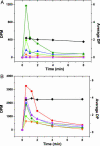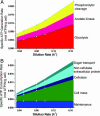Cellulose utilization by Clostridium thermocellum: bioenergetics and hydrolysis product assimilation
- PMID: 15883376
- PMCID: PMC1129095
- DOI: 10.1073/pnas.0408734102
Cellulose utilization by Clostridium thermocellum: bioenergetics and hydrolysis product assimilation
Erratum in
- Proc Natl Acad Sci U S A. 2005 Jun 28;102(26):9430
Abstract
The bioenergetics of cellulose utilization by Clostridium thermocellum was investigated. Cell yield and maintenance parameters, Y(X/ATP)True = 16.44 g cell/mol ATP and m = 3.27 mmol ATP/g cell per hour, were obtained from cellobiose-grown chemostats, and it was shown that one ATP is required per glucan transported. Experimentally determined values for G(ATP)P-T (ATP from phosphorolytic beta-glucan cleavage minus ATP for substrate transport, mol ATP/mol hexose) from chemostats fed beta-glucans with degree of polymerization (DP) 2-6 agreed well with the predicted value of (n-2)/n [corrected] (n = mean cellodextrin DP assimilated). A mean G(ATP)(P-T) value of 0.52 +/- 0.06 was calculated for cellulose-grown chemostat cultures, corresponding to n = 4.20 +/- 0.46. Determination of intracellular beta-glucan radioactivity resulting from 14C-labeled substrates showed that uptake is different for cellulose and cellobiose (G2). For 14C-cellobiose, radioactivity was greatest for G2; substantially smaller but measurable for G1, G3, and G4; undetectable for G5 and G6; and n was approximately 2. For 14C-cellulose, radioactivity was greatest for G5; lower but substantial for G6, G2, and G1; very low for G3 and G4; and n was approximately 4. These results indicate that: (i) C. thermocellum hydrolyzes cellulose by a different mode of action from the classical mechanism involving solubilization by cellobiohydrolase; (ii) bioenergetic benefits specific to growth on cellulose are realized, resulting from the efficiency of oligosaccharide uptake combined with intracellular phosphorolytic cleavage of beta-glucosidic bonds; and (iii) these benefits exceed the bioenergetic cost of cellulase synthesis, supporting the feasibility of anaerobic biotechnological processing of cellulosic biomass without added saccharolytic enzymes.
Figures




Similar articles
-
Kinetics and relative importance of phosphorolytic and hydrolytic cleavage of cellodextrins and cellobiose in cell extracts of Clostridium thermocellum.Appl Environ Microbiol. 2004 Mar;70(3):1563-9. doi: 10.1128/AEM.70.3.1563-1569.2004. Appl Environ Microbiol. 2004. PMID: 15006779 Free PMC article.
-
Carbon flux distribution and kinetics of cellulose fermentation in steady-state continuous cultures of Clostridium cellulolyticum on a chemically defined medium.J Bacteriol. 2001 Jan;183(1):119-30. doi: 10.1128/JB.183.1.119-130.2001. J Bacteriol. 2001. PMID: 11114908 Free PMC article.
-
Testing alternative kinetic models for utilization of crystalline cellulose (Avicel) by batch cultures of Clostridium thermocellum.Biotechnol Bioeng. 2013 Sep;110(9):2389-94. doi: 10.1002/bit.24914. Epub 2013 Apr 29. Biotechnol Bioeng. 2013. PMID: 23568291
-
Unravelling carbon metabolism in anaerobic cellulolytic bacteria.Biotechnol Prog. 2006 Sep-Oct;22(5):1229-38. doi: 10.1021/bp060016e. Biotechnol Prog. 2006. PMID: 17022659 Review.
-
Intracellular cellobiose metabolism and its applications in lignocellulose-based biorefineries.Bioresour Technol. 2017 Sep;239:496-506. doi: 10.1016/j.biortech.2017.05.001. Epub 2017 May 4. Bioresour Technol. 2017. PMID: 28535986 Review.
Cited by
-
Development of a Genome-Scale Metabolic Model of Clostridium thermocellum and Its Applications for Integration of Multi-Omics Datasets and Computational Strain Design.Front Bioeng Biotechnol. 2020 Aug 21;8:772. doi: 10.3389/fbioe.2020.00772. eCollection 2020. Front Bioeng Biotechnol. 2020. PMID: 32974289 Free PMC article.
-
Importance of Defluviitalea raffinosedens for Hydrolytic Biomass Degradation in Co-Culture with Hungateiclostridium thermocellum.Microorganisms. 2020 Jun 17;8(6):915. doi: 10.3390/microorganisms8060915. Microorganisms. 2020. PMID: 32560349 Free PMC article.
-
Deciphering Cellodextrin and Glucose Uptake in Clostridium thermocellum.mBio. 2022 Oct 26;13(5):e0147622. doi: 10.1128/mbio.01476-22. Epub 2022 Sep 7. mBio. 2022. PMID: 36069444 Free PMC article.
-
Direct glucose production from lignocellulose using Clostridium thermocellum cultures supplemented with a thermostable β-glucosidase.Biotechnol Biofuels. 2013 Dec 21;6(1):184. doi: 10.1186/1754-6834-6-184. Biotechnol Biofuels. 2013. PMID: 24359557 Free PMC article.
-
Enhanced cellulose degradation by targeted integration of a cohesin-fused β-glucosidase into the Clostridium thermocellum cellulosome.Proc Natl Acad Sci U S A. 2012 Jun 26;109(26):10298-303. doi: 10.1073/pnas.1202747109. Epub 2012 Jun 11. Proc Natl Acad Sci U S A. 2012. PMID: 22689961 Free PMC article.
References
-
- Berner, R. A. (2003) Nature 426, 323-326. - PubMed
-
- Melillo, J. M., Steudler, P. A., Aber, J. D., Newkirk, K., Lux, H., Bowles, F. P., Catricala, C., Magill, A., Ahrens, T. & Morrisseau, S. (2002) Science 298, 2173-2176. - PubMed
-
- Russell, J. B. & Rychlik, J. L. (2001) Science 292, 1119-1122. - PubMed
-
- Kamm, B. & Kamm, M. (2004) Appl. Microbiol. Biotechnol. 64, 137-145. - PubMed
-
- Wahlaud, B., Yan, J. & Westermark, M. (2004) Biomass Bioenerg. 26, 531-544.
Publication types
MeSH terms
Substances
LinkOut - more resources
Full Text Sources
Other Literature Sources
Research Materials
Miscellaneous

